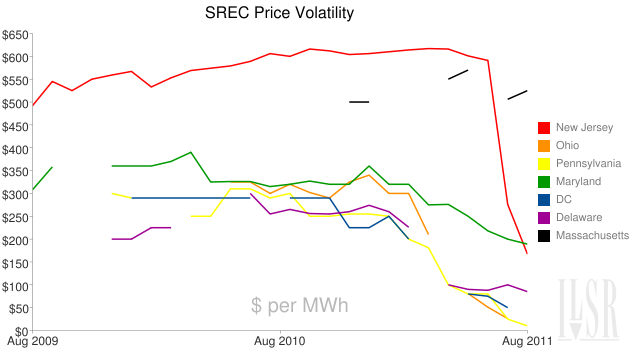 The energy market isn’t as free as we’d like to believe.Photo: USDAThis post originally appeared on Energy Self-Reliant States, a resource of the Institute for Local Self-Reliance’s New Rules Project.
The energy market isn’t as free as we’d like to believe.Photo: USDAThis post originally appeared on Energy Self-Reliant States, a resource of the Institute for Local Self-Reliance’s New Rules Project.
When it comes to solar policy in the U.S., there are three flavors: tax or cash incentives, long-term CLEAN Contracts, and solar renewable energy credit markets. Policy makers are often drawn to flavors that taste like markets, but unfortunately “market-based” and “cost-effective” aren’t synonyms in solar policy. Furthermore, by virtue of being available almost anywhere, renewable energy presents a unique opportunity to disperse the economic value of generating energy, and the right policy can make more of us into energy producers.
The three solar policy flavors
Incentives are simple: Pay people to go solar. The federal tax incentives are the backbone of solar financing, and programs like California’s Solar Initiative provide production-based payments that further reduce the breakeven price for a solar developer. Incentives work by closing the gap between what utilities want to pay for electricity and what it costs to go solar.
CLEAN Contracts are also simple: Provide people a long-term contract for solar power. In the German CLEAN Contract (or feed-in tariff) program, this means setting a contract price sufficient to provide a reasonable return on investment, based on the cost of installing solar. In the U.S., CLEAN Contracts have been set in this cost-based fashion, but also by using utility’s “avoided cost” rates (e.g. what they would have to pay to get electricity from another source). Both have worked, the former in Gainesville, Fla., Vermont, and San Antonio, Texas, and the latter in the Sacramento Municipal Utility District in California.
Solar renewable energy credit (SREC) markets are a bit more complex. First, the state mandates a certain quantity of solar, e.g. 1 percent of electricity by 2020, with incremental mandates each year. Then a market for SRECs is established. Each solar project gets one SREC for each megawatt-hour of electricity it produces. These SRECs are purchased by utilities in order to meet the state mandate. If the supply of solar is less than demand, prices jump. If the supply of solar exceeds demand, prices fall. It’s textbook economics. It can also be very volatile. The following chart illustrates SREC prices over the past two years in the eight states with active SREC markets, and shows the general collapse in value in the past six to nine months across nearly every state (when, for the first time, supply exceeded the state mandate).

The problems of “market-based” policy
SRECs are traded in a market, hence their claim to be market-based. But it’s an artificial market whose prices are totally reliant on the relationship between a state solar mandate and the supply of solar power. And as a new report from the Institute for Local Self-Reliance reveals, using SRECs may also be more costly than alternatives like CLEAN Contracts.
Why wouldn’t the SREC market be the most efficient?
For one, it’s a price set by an artificial state mandate for solar and has no real relationship to the actual cost of installing solar power. The following chart illustrates the relationship between SREC prices in New Jersey and the cost of installing solar power there. For comparison, it also shows the price of the German feed-in tariff (adjusted for the stronger New Jersey solar resource and federal tax incentives).

Of course, this isn’t apples-to-apples, because SRECs are sold on a spot market or shorter-term contracts (one to five years, typically), while a CLEAN Contract price is set for 20 years. But it does highlight how the former policy prices the artificial supply-demand relationship, while the latter is focused on administratively setting the contract price based on the cost of installing solar. If the policy administrators are adept at adjusting prices (the Germans do so twice a year, and a CLEAN Contract Program modeled on the CSI could do so automatically, based on a given quantity of solar installed), then CLEAN Contracts can be a very accurate measure of the cost of solar compared to SRECs.
The second reason CLEAN Contracts can beat SRECs on cost effectiveness is that they lower risk. If you’ve ever picked investments for a retirement fund, you know that more risk = more return. Savings accounts pay little because your money is safe. By the same principle, CLEAN Contracts can offer lower contract prices than SRECs because they offer transparency and certainty to investors in solar projects. They may also make life easier for solar installers, whose livelihood depends on consistency in the market. It remains to be seen how the solar markets of the many states with SRECs are affected by the crash in SREC prices.
Incentive programs fall in between SRECs and CLEAN Contracts. If consistent and predictable, like the California Solar Initiative, they can also lower risk and therefore the cost of solar. But if they take the form of rebate programs that are fully subscribed, expire, and then get renewed a year later, they will have to offer developers a higher return to take up the risk.
Ultimately, the transparency and certainty of the incentives is what makes financing solar cheap, and the longer this market certainty persists, the faster solar installers will drive down the cost of solar.
It’s also about ownership
Risk and return aren’t the only considerations. CLEAN Contracts dramatically simplify the process of going solar, so much so that half of Germany’s 53,000 megawatts of renewable energy are citizen-owned, not in the hands of utilities. The economic benefits to local communities are vastly higher when the bar to participation is dramatically lowered, and the democratization of energy production means a much stronger commitment to clean energy than when only the rich can play.
There are many good criteria for evaluating solar policy, from cost-effectiveness to the volume of solar to the democratization of ownership. “Market-based” fails to make the grade.



